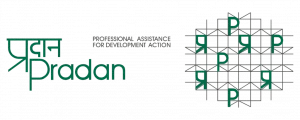Client Overview

PRADAN (Professional Assistance for Development Action) is a leading non-profit organization working since 1983 to empower India’s rural poor. Operating across eight states, PRADAN promotes Self-Help Groups (SHGs), builds sustainable livelihoods, and mobilizes government funding to fight poverty. By March 2023, it had impacted 2.64 million rural households in 25,421 villages across 133 districts. To support its large-scale operations and enhance efficiency, PRADAN partnered with Indictrans for ERPNext implementation for HR, payroll, budgeting, and finance.
The Challenges
Managing internal operations for an NGO of PRADAN’s size came with several roadblocks:
1. Unclear and Inconsistent Processes
- Processes were not standardized and often interpreted differently across departments.
- Lack of alignment led to delays in validation and decision-making.
2. Inefficient Stakeholder Collaboration
- Delayed approvals and sign-offs slowed down the organization’s processes .
3. Manual and Error-Prone Operations
- Payroll and HR processes were heavily manual, consuming time and leaving room for errors.
- Budgeting lacked transparency, with limited visibility into fund allocations and expenditures.
4. Compliance and NGO-Specific Needs
- PRADAN required strict adherence to FCRA (Foreign Contribution Regulation Act) compliances.
- Complex payroll structures across different employment types required significant customization.
Goals & Requirements
PRADAN wanted an ERP system that could:
- Automate HR and payroll to reduce manual interventions.
- Streamline budgeting and finance with better controls and transparent reporting.
- Ensure NGO-specific compliance, including FCRA and multi-dimensional reporting.
- Support scalability, allowing new modules and processes to be added in the future.
You can check out our previous case study on: Whitehats Automates Billing with ERPNext Success Package
Our Approach & Solution
Indictrans adopted a waterfall methodology with a phased rollout to ensure smooth adoption while minimising risks.
Key Customisations Delivered
HR & Payroll Automation
- Development of a separate Apprentice Master linked to the Employee Master.
- Automatic leave policy assignment based on employment type and gender.
- Workflows for probation, contract renewal, and final settlements.
- Payroll logic supporting multiple pay scales.
- Automated TDS and house rent allowance (HRA) calculations.
- Employee transfer salary adjustments across locations.
Budgeting & Finance
- Budget planning before each fiscal year, with allocations by project, team, and natural heads.
- Sub-ledger accounting with multiple dimensions.
- Integrated FCRA compliance into accounting workflows.
- Dashboard-driven budget monitoring and reporting.
Procurement & Assets
- Asset lifecycle management with automated depreciation tracking.
- Procurement process automation with custom approval workflows.
Data Security & Role-Based Workspaces
- Workspace restrictions to ensure data relevance and confidentiality.
- Example: Self-Service Workspace restricted by employee ID; FRC Associate Workspace restricted by team.
Data Migration Strategy
- Developed a step-by-step roadmap for importing complex, interdependent datasets.
- Conducted detailed data preparation and validation in Excel to minimize errors.
Testing & Deployment
- Functional testing and UAT cycles were conducted iteratively.
- Comprehensive scenario-based testing ensured workflows were stable before going live.
- Misconfigurations during go-live were resolved quickly by reconfiguring and re-importing data.
Overcoming Challenges
Like any large-scale ERPNext implementation, the project came with hurdles:
- Changing Requirements: Frequent changes after development had started were managed by stabilising modules before accommodating change requests.
- Team Transitions: Changes in point-of-contact led to confusion, resolved through clear documentation and alignment.
- Delayed Feedback: Addressed by phased releases and continuous communication.
- Budget Performance Issues: Optimized the first phase, with further enhancements planned.
Outcomes & Impact
The ERPNext implementation enabled PRADAN to:
1. Save Time and Increase Efficiency
- Payroll and HR operations were automated, saving significant time.
- Standardized workflows reduced ambiguity and manual dependencies.
2. Improve Financial Transparency
- Real-time budget monitoring with accurate fund allocations.
- Custom dashboards and reports gave management actionable insights.
3. Ensure Compliance and Audit-Readiness
- FCRA compliance integrated into accounting processes.
- Multi-dimensional reporting strengthened audit readiness.
4. Enhance Security and Control
- Role-based access ensured employees only viewed relevant data.
- Workspace restrictions created secure, contextual access.
Key Results Snapshot
- 60% reduction in manual HR and payroll effort
- Real-time budget tracking across multiple projects and teams
- FCRA-compliant accounting integrated into ERP workflows
- 250+ staff empowered with secure, role-based access
Post-Go-Live Support
Indictrans continues to support PRADAN with:
- Continuous monitoring and HyperCare services.
- Optimisation of performance-heavy modules like Budgeting.
- Ongoing enhancements and additional module requests.
Closing Note
Through ERPNext, PRADAN has successfully standardized and automated its core operations HR, payroll, budgeting, and finance while ensuring compliance and transparency.
This implementation not only improved organizational efficiency but also freed up PRADAN’s staff to focus more on their core mission: empowering rural communities to escape poverty and live with dignity.
Let’s discuss how ERPNext implementation enhances organizational efficiency.
For More Information: LinkedIn.






